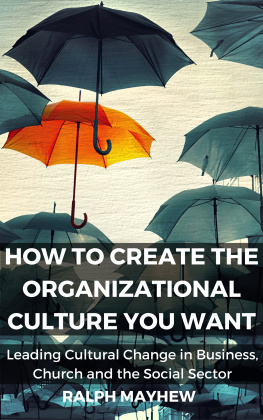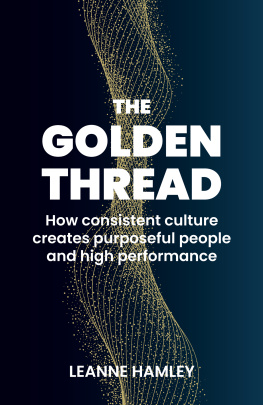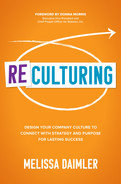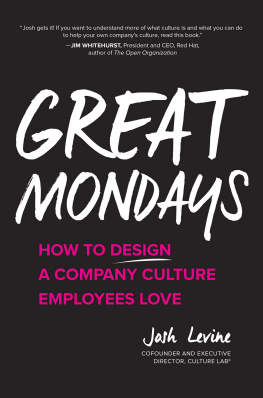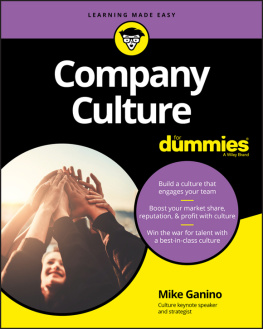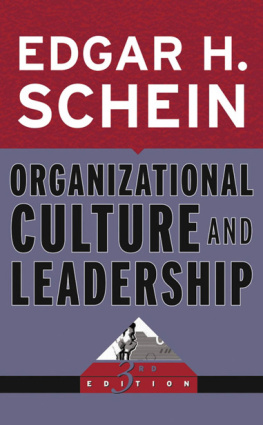
CULTURE SHIFT
PRAISE FOR CULTURE SHIFT
The mix of personal experience and straight-talking advice creates a vital handbook for anyone taking on the task of managing culture.
SUNNY VARKEY, Founder of GEMS Education and Varkey Foundation
I taught culture at a business school for years, and always felt that I was about to get found out, because all the models I came across sounded plausible but simply didnt work. I wish Id had this book, and I wish Id written it. Bravo it should be issued to all new leaders along with their security pass on day one.
EVE POOLE, author of Leadersmithing
Culture is so fundamental to peformance, and yet working to improve it often attracts myth, mystery and scepticism. Seen on the one hand as the intangible soft stuff, or on the other as something simplistically to be fixed, neither approach will be successful. This books finds a way through the middle, based on real experience and outcomes. Its straight talking, realistic and refreshingly honest. And its proven. I know I worked closely with the author in some of the case studies referenced. If you are approaching the topic of driving change through culture, start here with this book. It will help you make sense of a topic so often avoided, yet so essential to grasp.
IAIN CONN, CEO Centrica Plc
One persons logic is not anothers a key premise of this accessible book that unpicks why you cant simply announce the culture you want, and expect to create it. It takes time, effort, balance and a healthy dose of pig-headedness. Wonderful, original stuff.
CHARLIE HODGSON, Team and Leadership Coach
For
David, George & Freddie

CONTENTS
Why this book is needed
Culture eats strategy for breakfast that over-used nugget of wisdom, never more fashionable in the business world than in the aftermath of the global financial crisis. But do people really understand what that means, and more importantly, how to make it happen?
A common practice in too many businesses (especially large, established ones) is to see culture change as a project, with a start and an end; to hand it to someone in HR, to bring in a team of consultants who will use data analytics and textbook models to define todays culture and outline tomorrows required state, and then create and track a perfect plan of activity to drive towards that end state. After 612 months, they will have delivered their brief, and while there will be an observable shift in behaviour in the organization for the duration that the focus remains overt many will continue the way they have always worked. Either way, once the project is considered done, the dominant culture re-emerges and things go back to how they were.
This book is about how to do things differently, so that the culture really does shift. Its about the very top leadership owning their work and using their own talent from the line to lead it. No external consultants, minimal budget (if any), setting goals not plans, direction not precision, and putting the culture work at the core of running the business, on an ongoing basis; not just as a one-off fix.
Managing culture in an organization is neither as creative and unbounded as an art, nor is it as precise and as empirically evidenced as a science.
It is a craft: a blend of the two. And its challenging and rewarding work.
I want to encourage you to turn traditional thinking on its head whichever way you would normally approach this, were going to learn how to do the opposite.
Whos the audience?
This book is for anyone who has the responsibility to shift the culture of an organization:
From CEOs to employees: individuals who have been handed the task by someone more senior.
For sceptics: I will explain how culture makes a difference, how change can be made, and how its more than just HR professionals hugging trees. Culture is the core of business and this book will show you why, and how to make sense of it, manage it and shift it.
For aspiring leaders: to those who think they have been given an impossible task, I will explain how establishing a culture is actually the greatest opportunity available. The ability to see the whole company, to influence its future, and to work closely with the top team as well as across the organization sets you up for the future and ensures you have a legacy. Its challenging, insightful and hugely rewarding.
For the human resources manager: I will show you how to fight HR-sceptics and stop pushing water uphill, by ensuring your colleagues are leading the push from the frontline.
And for the change agent: the individual whos tried everything and is out of ideas, but willing to give it one more shot. This book is full of ideas to help you think differently, break eggs, stop following plans, and go for it. It wont be easy (youre used to that), but you will be able to make a difference and you will be valued.
This book will show you how the person overseeing this work should be the air-traffic controller, not the pilot of the plane. This analogy is fundamental to managing and shifting a culture sustainably.
Anyone who has ever tried to lead a shift in behaviour will know that telling a person how to behave only causes them to react against you. Instead, your role is to be the architect of the environment, channelling the workforce into a certain way of behaving, and ensuring that the behaviour that is required becomes the norm. You are not telling the pilot how to fly the plane or flying it yourself, but are creating the clear environment in which they can fly and land safely, without crashing into others. Its fundamental that you become an expert at setting those parameters, scanning the environment for potential threats, misalignment and weak signals. Others have to trust you to accomplish this, and in return you have to trust them to do their job. Setting expectations together is vital here.
Within these pages I will explain how to hold the whole picture, the environment, and how to see dynamics play out from all the different angles and stakeholders. I will explain how to set the parameters in order for the shift to happen, and how to ensure individuals trust that you comprehend the bigger picture and have the skills and credibility to direct the process, without having to micromanage their jobs or priorities. I will give you the tools and knowledge, so you are equipped with the authority to ensure others operate within those parameters, while the boundary of your remit remains clear.
Why is it different and why now?
This is not a book full of academic models about organizational culture, but a practical guide about how to shift and manage one. It is based on 28 years experience of corporate life, with five years of leading a shift in work culture in an organization of 80,000 people in 80 countries.
And now is the prime time for you to discover it.
Behavioural economics is finally, and rightly, emerging into the daylight of established practice, with the 2017 Nobel Prize for Economics going to Richard Thaler and his work on the topic.
As this guide is founded on behavioural economics, it recognises that people do not make average assumptions and do not always (or often) follow what others may view as rational logic. Shifting and managing a culture is thus not about telling people what to do and expecting them to neatly fall in line, but about recognising where they really are and how they make decisions; all so that you can start to shift the environment, influencing them to make different decisions and form new habits.
Next page

